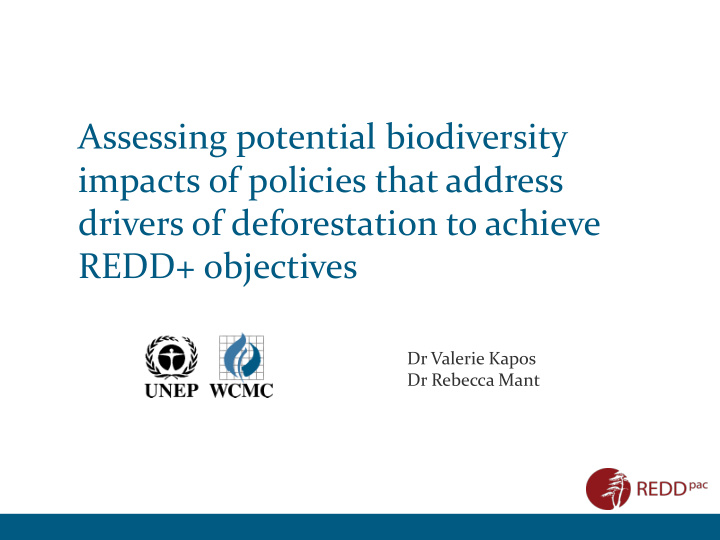



Assessing potential biodiversity impacts of policies that address drivers of deforestation to achieve REDD+ objectives Dr Valerie Kapos Dr Rebecca Mant
REDD+ and drivers of deforestation (a) Reducing emissions from deforestation ; (b) Reducing emissions from forest degradation ; REDD + (c) Conservation of forest carbon stocks; (d) Sustainable management of forests; (e) Enhancement of forest carbon stocks . IUFRO
REDD+ and biodiversity conservation REDD+ activities e.g. reduced deforestation Opportunities Risks e.g. Slowed loss & e.g. Displacement of land- fragmentation of use change to ecosystems habitat important for biodiversity IUFRO
REDD+ and biodiversity Safeguard (e) UNFCCC “That actions are consistent with the conservation of Cancun natural forests and biological diversity, ensuring that [actions] are not used for the conversion of natural Safeguards forests, but are instead used to incentivize the protection and conservation of natural forests and their ecosystem services, and to enhance other social and environmental benefits ;” Aichi Biodiversity Targets CBD • Target 5 “By 2020, the rate of loss of all natural Strategic habitats, including forests, is at least halved . . .” • Target 15 “By 2020, ... the contribution of Plan biodiversity to carbon stocks has been enhanced, . . . including restoration of at least 15 per cent of degraded ecosystems, . . . IUFRO
REDD-PAC project “REDD -PAC aims to support the design of national and regional REDD+ policies that safeguard and enhance ecosystem services , in particular those services distinguished by the United Nations Convention on Biological Diversity” • Integrated land-use modelling (GLOBIOM) to assess impacts of REDD+ policy options • member countries of the Central African Forests Commission (COMIFAC) • Brazil • Spatial analysis of potential benefits from REDD+ in 5additional countries IUFRO
Using land use models to asses impacts Drivers of land use change CO 2 Changes in Emissions trade Change in Policy Land use Changing & & diets Context Land cover Biodiversity (moderators) Growing Populations Production . . . IUFRO
Challenges Drivers of land use change CO 2 Changes in 1 2 3 Emissions trade Change in • Identifying nationally • Reconciling model • Assessing Policy Land use relevant and realistic land use categories impacts on Changing & & diets policy options & changes with biodiversity Context Land cover actual land uses and of different • Expressing them in Biodiversity (moderators) associated land policy terms suitable for Growing cover options Populations modelling Production . . . IUFRO
Challenges: 1. Policy Options • Many countries are still developing REDD+ strategies • Brazil is likely to focus on increasing enforcement of the current forest code and related policies • REDD-PAC is first exploring: - Impact of protected areas (by comparing land use change with and without them). - Impacts of enforcing forest code re-forestation requirements. Preliminary results on levels of deforestation with different levels of enforcement of the reforestation requirements within the forest code. IUFRO
Challenges: 2. Reconciling land uses/covers and understanding changes Increase in Preliminary results – productive area change in productive area 2000-2010 Decreases in: • forest • ‘other natural land’ • Secondary vegetation • Remnants primary veg. IUFRO
Challenges: 2. Reconciling land uses/covers and understanding changes Increase in productive area Decreases in forest and ‘other Preliminary results – natural land’ change in productive area 2000-2010 Ancillary data used to assess minimum decrease in primary vegetation remnants due to increases in productive use IUFRO
Challenges: 3. Assessing impacts on biodiversity Projected land use/cover change under different policy options explored in terms of: • Changes in “important” places o areas identified as important for biodiversity conservation o ecosystems of concern • Changes within species ranges o Different types of species o All species combined IUFRO
Change in biodiversity priority areas – e.g. preliminary results for Brazil National priority areas for biodiversity conservation (MMA, Brazil 2007) IUFRO
Assessing land use change in biodiversity priority areas IUFRO
Land use change in biodiversity priority areas: Amount of converted land within priority areas in each cell Initial draft results from Brazil Minimum Maximum IUFRO
Change within species ranges e.g. Chimpanzee range in DRC IUCN distribution data on mammal, bird, amphibian species (total 1637 in DRC) + Species habitat preferences Change in suitable habitat within extent of occurrence of each species Chimpanzee extent of occurrence in DRC overlaid on modelling units IUFRO
Change within species ranges: all species or key subsets e.g. Preliminary results: Combined impact on threatened species in DRC Change in suitable habitat within extent of occurrence of each species can be weighted in relation to total available Spatial distribution habitat and of impact across combined with species results other species for an overview of biodiversity impact IUFRO
Next steps Modelling specific policy options o Brazil: how do biodiversity impacts differ if efforts to enhance implementation are concentrated on forests in biodiversity priority areas o Congo Basin: identifying & modelling options common to emerging REDD+ strategies in several countries • e.g. increase in protected areas; improved agricultural management/production Using national biodiversity data including species range data. IUFRO
Thank you for listening, Any Questions? Valerie.Kapos@unep-wcmc.org IUFRO
Recommend
More recommend